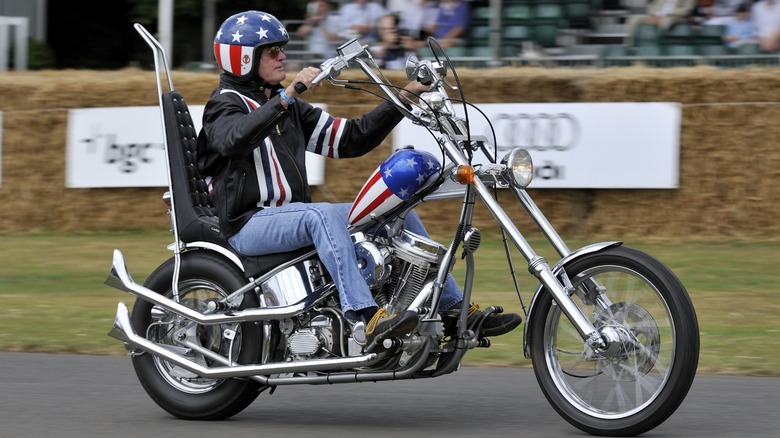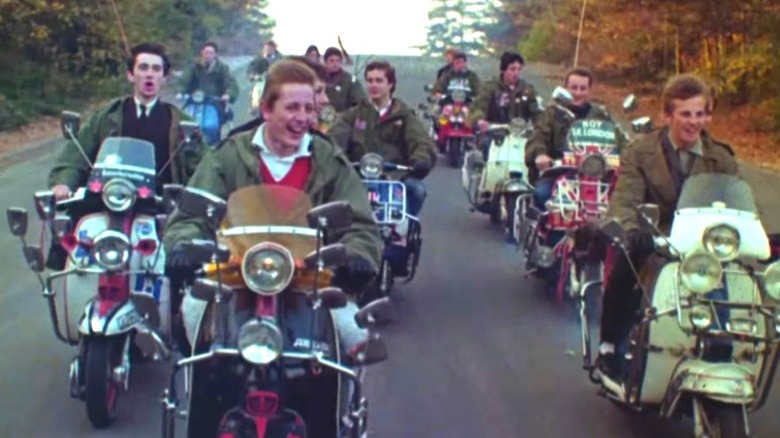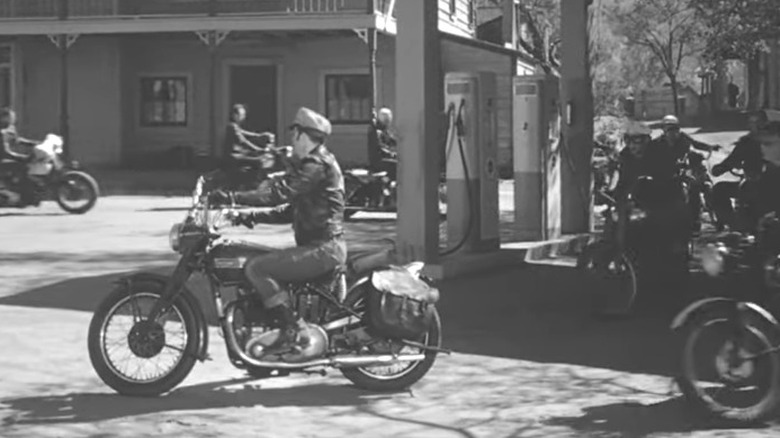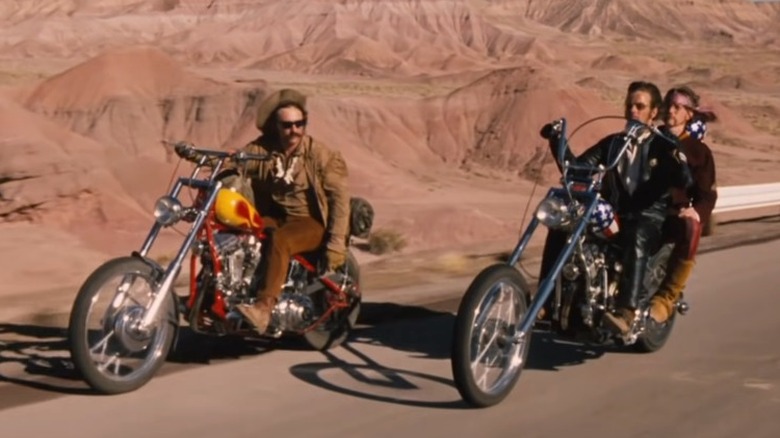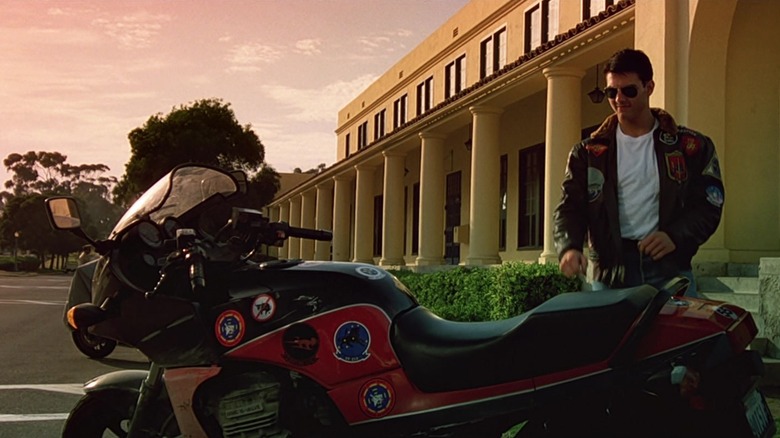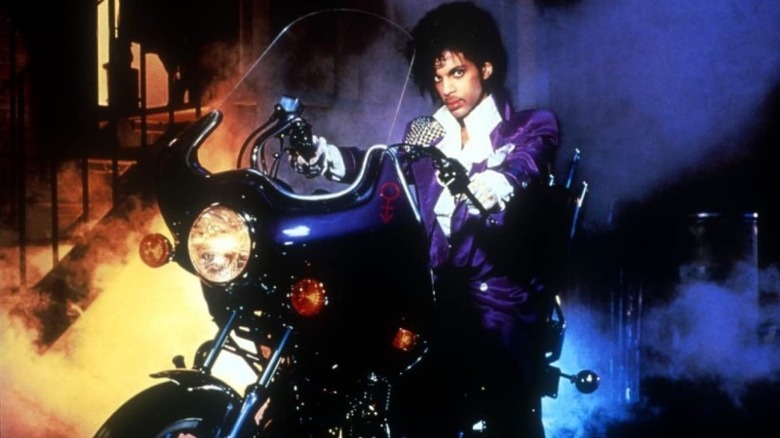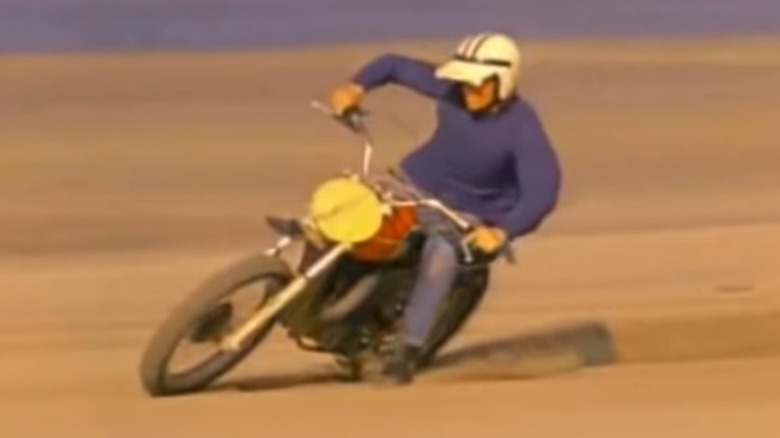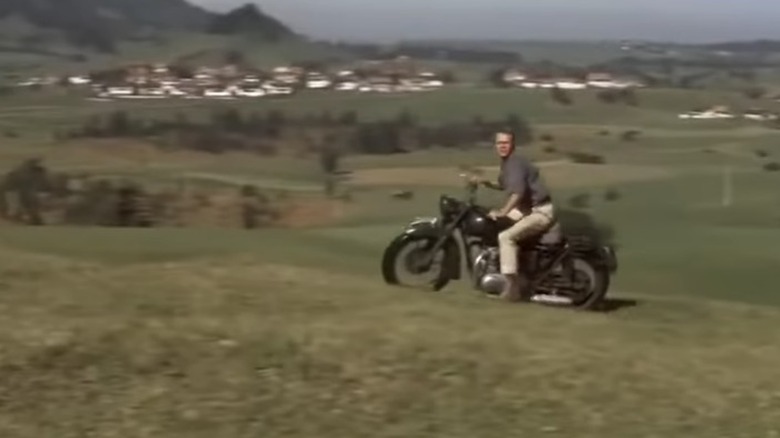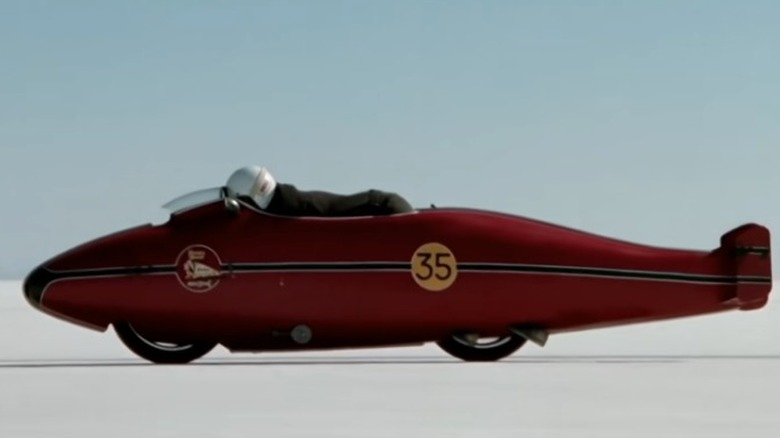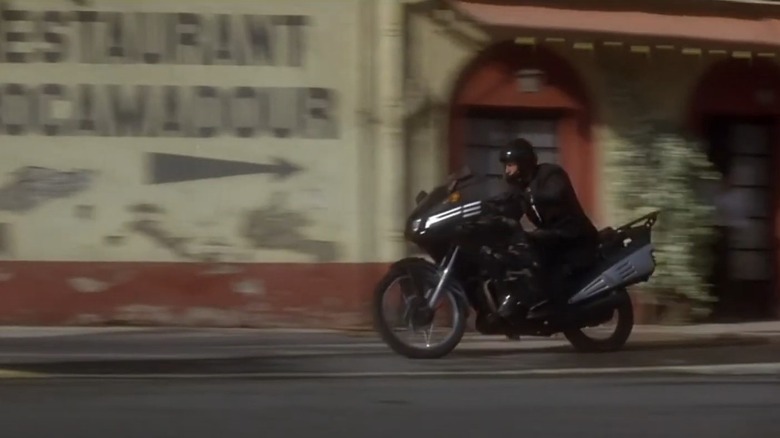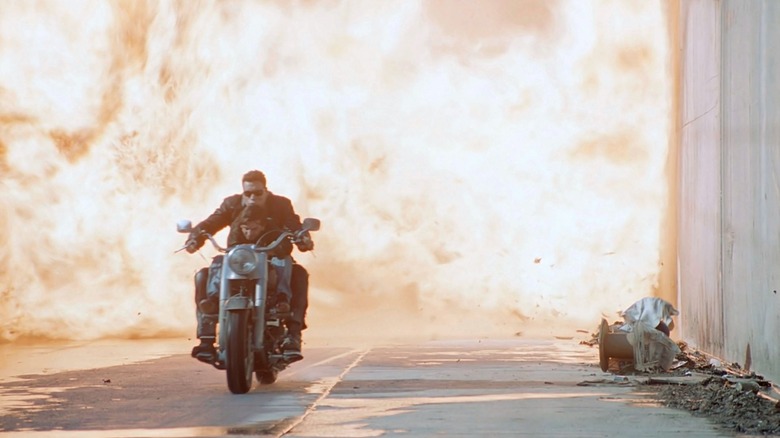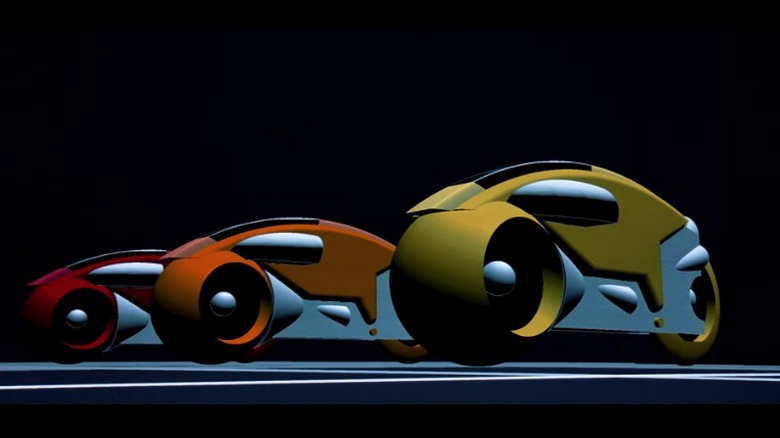The 10 Most Famous Movie Motorcycles Of All Time
From the moment that the invention of moving pictures came to be, various facets of life became a part of film. The earliest silent movies prominently featured trains, and automobiles entered the frame shortly thereafter. Likewise, bicycles on the street were shown and the popularity of motorcycles meant they were also captured by the camera. Since those early days, motorcycles have shown up in all manner of films from drama to horror, with motorcycles often becoming as much of a character as the ones portrayed by the actors. Sometimes motorcycles were used to deposit unsavory characters while often they are means of escape for the hero and protagonist.
Regardless of purpose, motorcycles sometimes can captivate certain portions of an audience, particularly the enthusiast of two-wheeled mechanized transport. Motorcycles from Britain, Japan, America, and elsewhere are used in movies, with some models on occasion being dressed up by the prop master to represent something else. Furthermore, motorcycles present unique opportunities to capture elaborate stunts and chase scenes in particular. No matter how a cycle is used in a movie, many of us will appreciate its inclusion. Whether they are used by hero or villain, these 10 bikes are the most famous movie motorcycles of all time.
Lambretta LI150 - Quadrophenia (1979)
The 1979 film "Quadrophenia" tells an old tale of youth. This film, set in 1965, follows the exploits of a couple of rebellious youth gangs in working-class London. The film is an adaptation of a rock opera released by The Who in 1973 and follows Jimmy, who gets away from his dreary days working in a mailroom by joining his band of fellow Mods cruising the streets on his highly customized Lambretta scooter. His fellow Mods also ride a variety of Lambretta and Vespa scooters, affixed with an absurd array of rear-view mirrors, chrome luggage racks, and crash bars. Throughout the film, Jimmy and his band of Mods partake in their favorite pastimes of consuming drugs and alcohol before going to brawl with Rockers, their nemesis band of hooligans on classic British motorcycles (via Rolling Stone).
While the movie primarily deals with disaffected youth and their trials in becoming adults, there is no doubt that the two-wheeled machines on both sides are central to the story. Jimmy's bike is a 1967 Lambretta LI150 outfitted with six additional mirrors, chrome crash bars, a tall passenger backrest, checkered mudflap, custom spare tire cover, a foxtail on a tall whip antenna, and more. It is also covered in a custom paint scheme with various stickers. The highly ornamental scooter from the film was saved after production wrapped and has since been sold by Bonhams with a winning bid of $42,723 in 2008.
Triumph Thunderbird T6 - The Wild One (1953)
Actor Marlon Brando is a giant of Hollywood, standing as one of the greatest actors of his generation. He got his start on the silver screen shortly after the end of World War II and among his early films was "The Wild One" of 1953. This film follows another biker gang, but rather than groups of bikers pitted against each other, this follows a group pitted against the common decency of citizens in small-town America. When Brando arrives as Johnny Strabler with his group, the gang upends the tranquility of the town with loud and smelly motorcycles accompanied by the group's garish attire and foul language -– foul in the context of 1953 America, but rather tame by today's standards. With the shenanigans having awoken a sense of righteous indignation among the locals, a group assembled to deliver a bit of mob justice, only to result in the death of one of the locals (via Deep Focus Review).
While the film is ostensibly a warning against youthful hooliganism, it sparked an interest in rebellious counterculture and sealed Brando's place as a cool leading man in film. The wild biker types represented in the film often rode imported British bikes back in the day, including BSA, Triumph, and Norton models. For the movie, Brando, an avid rider, rode his own Triumph Thunderbird 6T on screen, according to HotCars. The image of Brando and his comrades on their rumbling motorcycles clad in leather jackets and hats defined that of a motorcycle outlaw for a generation.
Harley Davidson Panhead - Easy Rider (1969)
The 1960s were a tumultuous time in the United States. Political movements were pulling in every direction and the youth more than ever broke free from the norms of the day to express their freedom and independence, and perhaps no other film of the day represents this feeling more than the iconic "Easy Rider." As an independent film featured at Cannes, its producers probably did not know it would, in part, define a generation. It did, however, earn Columbia Pictures $60 million, according to The Guardian.
By the time this movie came out Jack Nicholson, Dennis Hopper, and Peter Fonda were already seasoned actors who could take risks being involved in a project including risque topics. "Easy Rider" bucks norms, but it is essentially about freedom and what it means to grow up and be a free American. An integral part of this theme is a pair of motorcycles used to ride cross-country, including a somewhat harrowing journey through the South. Both of the bikes are customized Harley-Davidson from the early '50s featuring the classic v-twin Panhead engines, so called for the shape of the valve covers (via Legendary Motorcycles by Basem Wasef and Jay Leno). The bikes were customized in the "chopper" style with long, raked forks and custom paint. Fonda's "Captain America" bike features particularly long forks, a lack of front fender, and an extra-tall sissy bar, which is used by a straight-laced Nicholson after he joins the pair wearing a football helmet.
Everything about this film is now iconic. It is a well-known cult classic and continues to be loved by fans. The bikes are loved so much, the "Captain America" bike sold in 2014 at auction for a staggering $1.35 million, according to the Los Angeles Times.
Kawasaki GPZ900 - Top Gun (1986)
The 1986 movie "Top Gun" was in the top 10 movies of the 1980s by ticket sales — by far number one for 1986, per IMDb – and remains one of the most talked about films today, especially with its sequel being released 26 years later. For children of the '80s, "Top Gun" showcased the best of aviation technology in the Grumman F-14 Tomcat fighter jets going up against — and defeating — their Soviet MiG-28 counterparts, played in the film by Northrop F-5 Tiger II aircraft. While the film is full of a healthy dose of patriotic jingoism and good old-fashioned macho brinkmanship, it still delighted most kids of the era who, much like the protagonists, had "a need for speed."
Of course, fighter jets played leading roles in this film, they were joined by Tom Cruise, Val Kilmer, and Kelly McGillis all taking part in one way or another in the prestigious TOP GUN flight school of the U.S. Navy. During the film, McGillis drives a beautiful silver Porsche 356 spyder, but the other main attraction is flying ace Maverick's (Tom Cruise) Kawasaki GPZ900R Ninja motorcycle. The GPZ900R line debuted in 1984 and was built as a follow-up to its legendary Z1 superbike of the early 1970s. According to Ride Apart, it was among the first motorcycles to use the engine as a stressed member of the frame, integral to the structure of the bike and a weight-saving feature. It was the first motorcycle to top the 150 mph mark, and its sheer performance is part of the reason it appeared in a movie about the fastest machines on the planet.
Honda CM400 - Purple Rain (1984)
Prince Rogers Nelson was an unstoppable force of talent whom we are fortunate to have graced our presence in his less than six decades on the earth. Breaking onto the music scene in the late '70s, Prince immediately showed the world that he was a different sort of entertainer with amazing musical ability — and he was also a skilled actor. His film debut, "Purple Rain," could be mistaken for an autobiographical work as it followed the trials of a young musician trying to keep things together as he tries to make it with his music.
"Purple Rain" is a film known as much for the musical album that accompanied the film as the film itself. Songs from the movie have become timeless classics from one of the best musicians of the modern era — Prince could play 27 instruments, after all. Prince himself is also known for his enduring sex appeal, and that seems to drip down onto his main mode of transportation throughout the film, his 1981 Honda CM400 motorcycle with full fairing, windshield, and yet another extra-tall rear backrest. The Honda CM400 is one of a few motorcycles produced by Honda in that period with a version of automatic transmissions. The Hondamatic motorcycle used fluidic drive transmission with just a high and low gear driven through a torque converter and only stayed on the market for a few years.
A Honda CM400 is not usually a bike to get much press coverage as they were not highly successful, nor powerful and unique. Info about the original screen used bike is scarce, but many adoring fans have produced replicas to show their devotion to The Purple One.
Husqvarna 400 Cross - On Any Sunday (1971)
The 1971 documentary film "On Any Sunday" features what appears to be every model of dirt bike on sale in 1971 and the illustrious and fearless icon of the screen and track, Steve McQueen. While McQueen is the highest profile inclusion in the film due to his highly successful career as an actor, the film is full of guys who are equally successful, but lesser known, in pursuits of machine and track.
"On Any Sunday" explores the world of motorcycle racing, highlighting flat-track racing, and road racing, and it devotes much of its attention to dirt bike racing. Flat-track and road racing had been around for some time, but dirt bikes were relatively new in the early '70s. The film features bikes from Yamaha, Honda, Kawasaki, and Hodaka. But besides Steve McQueen, the star of the show may have been the Husqvarna 400 Cross, one of the best dirt bikes of its day.
At the time and even today, most dirt bikes have engines of 125 or 250cc displacement. All of the early ones were two-stroke, and even with 250cc engines, the power to move these light frames was significant. The 400 Cross was a bigger version that still only weighed 231 pounds, per American Motorcyclist. AMA Hall of Fame member Malcolm Smith rides this bike prominently in the film and is on it during an extended clip of come recreational riding done with McQueen. The film turned out to be a big sales booster for Husqvarna and it remains a must-see film for any dirt bike fan today.
Triumph TR6R - The Great Escape (1963)
Stalag Luft III was deep in the heart of Germany and held hundreds of Allied prisoners, including dozens of airmen who had been shot down. During his time in the camp, Paul Brickhill chronicled an elaborate plan of escape in which 76 prisoners made it out of the highly fortified "escape-proof" camp.
The operation, according to History, involved complicated coordination among prisoners to tunnel below the barracks and out past the edge of the camp in tunnels dug nine feet below the surface to evade detection. The plan was brilliant and used all manner of clandestine supplies to keep it hidden from the Nazi guards, and it was ultimately successful in getting 76 prisoners free. Sadly, 73 were caught and Hitler demanded to have 50 of them executed as a warning to the rest.
"The Great Escape" was turned into a 1963 film with an all-star cast, including Steve McQueen. In one of the finest scenes in the movie, McQueen's character manages to escape and steal a Nazi motorcycle, leading soldiers on a rousing chase over the rolling hills of the German countryside. Sadly, it ends with his capture. While Nazis generally rode BMW motorcycles, McQueen rode a Triumph TR6R, one of the leading bikes of the time. According to Hagerty, McQueen was forced to give up racing to continue to star in movies as the production studios would not allow him to do both. McQueen used "The Great Escape" to continue riding as he filmed most of his riding scenes, helping to get the film Academy Award nominations and a legacy of being one of the best films of all time.
Indian Scout - World's Fastest Indian (2006)
Today, we have countless ways for man to travel at extremely high velocities on land, air, and water. For wheeled machines over land, speeds once unthinkable can be achieved by regular passenger cars and even production cars can now easily break the 200 mph mark. But we had to put in some effort to get to this point, and a New Zealand character named Burt Munro set out to break this limit in an unorthodox fashion more than a half-century ago.
Immortalized in the movie entitled "The World's Fastest Indian," Munro, played by the incomparable Sir Anthony Hopkins, customizes a 1919 Indian Scout. By the time Munro brought his bike to the Bonneville Salt Flats of Utah, it was already 40 years old but had changed significantly since new. 1919 Scouts, according to Motorcycle News, came with 600cc V-twin side valve engines and a three-speed gearbox with hand operated shifter. The top speed was just 50 mph.
The most remarkable part of the story is Munro himself. He toiled in a shed on his motorcycle to make it go faster as a personal challenge. The engine was first bored out to 883cc, and later to 1,000. He fabricated many parts himself, including an aerodynamic covering to allow him to slip through the air with minimal drag. Despite being told many times over that he could never use his old Indian to break a record, he officially hit 190.07 mph in 1967. Incredibly, he was 66 years old at the time and remains the fastest rider of any Indian motorcycle to date.
Yamaha Seca 650 Turbo - Never Say Never Again (1983)
When "Never Say Never Again" was released, Sean Connery had not played James Bond since Roger Moore took over in 1973, and had proclaimed he would never be Bond again. Due to odd licensing arrangements, Connery's film was in theaters at the same time as Moore's "Octopussy," and both were big hits (via Yahoo! News).
While Connery reprises his role as 007, he is also matched up against his long-absent nemesis — licensing also prevented Blofeld from being used for many years — and happens upon a plot by the villainous criminal organization SPECTRE. A Bond movie is not complete without the agent having a bit of technical help from Q, and "Never Say Never" is no exception. However, in this film, Bond is not seen in his usual English motorcar, but on a Japanese motorcycle.
Bond engages in the obligatory car chase this time running after a femme fatale in the excellent mid-engine Renault R5 Turbo riding a Q-modified Yamaha Seca 650 Turbo. The Yamaha turbo bike was not a highly successful bike, but it is an attractive machine that exudes an '80s aesthetic. It was one of a few turbo motorcycles that appeared in the early '80s, but excessive turbo lag proved problematic when larger engines accelerated faster and easier with less complex engines and lower production costs, forever killing the concept.
Harley-Davidson Fat Boy - Terminator 2: Judgment Day (1991)
Seven years after we were introduced to Arnold Schwarzenegger as a cybernetic hitman from the future, he returned to reprise his role as the T-800 model Terminator in the sequel. In this second installment, the safety of John Connor continues from the first film to be paramount to the long-term success of the resistance movement in the future. As the T-800 performs its mission, it encounters the T-1000, which is found by the audience to be another android from the future that was formed from a liquid metal alloy using nanotechnology allowing it to morph into nearly any shape. Its ability to mimic persons it encounters also gives it the most effective camouflage.
The movie was, per Hollywood Reporter, another hit for the franchise, grossing $520 million at the box office, leaving us with many memorable scenes. Soon after the film begins, a young John Connor on a dirt bike has the T-1000 on his tail in a semi-truck while the T-800 unit pursues riding a Harley-Davidson Fat Boy. The actual model was a 1991 FLSTF Fat Boy and five were bought for the movie. They featured the iconic V-twin engines that were 81 cubic inches producing 48 horsepower, which pushed the bikes to a top speed of 92 mph.
"Terminator 2" helped boost sales and Harley has kept the bike in production ever since, making another appearance in the latest "Terminator: Genisys" movie (via South Bend Tribune). Fat Boys are as iconic as the Terminator movies and both have permanent places in pop culture. For the film-used bikes, the place has raised its stature to the point that in 2018, one of the bikes ridden by Schwarzenegger sold for nearly half a million dollars, per Motorious.
Bonus: Tron Light Cycles
In 1982, Disney was well known for its grand animated features, but even the godfather of children's entertainment needs to venture outside of its comfort zone sometimes. To that end, Disney released "Tron," a computer sci-fi adventure utilizing the most advanced special effects available to producers. It was released to much fanfare and ended up being praised for its technical achievements, although the script and character development were widely panned (via The Digital Bits).
In the movie, Kevin Flynn, played by Jeff Bridges, finds himself digitized into a computer program where he is trying to prove his computer programs had been plagiarized by his former employer. In a sort of man versus evil corporation, he must go through several challenges within this digital world to prove the guilt of the corporation's CEO. His success lies partly in his ability to prevail in challenges presented to him because they are programs that he wrote himself. One of the most popular of these is a challenge riding light cycles, futuristic digital motorcycles that emit lines of light through which opponents cannot cross without sudden death.
The light cycle scene is one of the best remembered of the movie and has held a legacy in popular culture that has lived on through the decades. They made another appearance in the second film in 2010, "Tron: Legacy," and the updated cycles have made it into a ride at Disney Shanghai. Parker Brother Concepts of Florida took it one step further and created operational Tron light cycles that can be driven on the streets. But, looking at famous movie motorcycles, real or not, it is hard to deny Tron light cycles are among the best.
